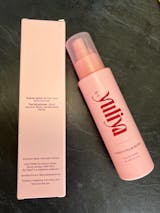How to Dermaplane (AKA Shave) Your Face at Home
If you're looking to achieve radiant, smooth skin without visiting a professional, dermaplaning at home might be your solution.
This exfoliation technique has gained popularity for its ability to remove dead skin cells and peach fuzz, offering a fresh, youthful glow.
Done properly, dermaplaning can improve skin texture and product absorption, but it’s essential to follow the right steps and use the right tools.
In this guide, we’ll walk you through how to dermaplane your face at home, what to watch out for, how often you should do it, and some product recommendations to get started.
What Is Dermaplaning?
Dermaplaning is a non-invasive skincare treatment that uses a sterile razor to gently exfoliate the surface of the skin.
By removing dead skin cells and the fine vellus hair (peach fuzz) on the face, dermaplaning leaves your skin feeling smooth and looking radiant. It also helps skincare products penetrate better and ensures makeup goes on smoothly.
What to Watch Out For
While dermaplaning is generally safe, there are a few key things to keep in mind before starting:
-
Skin Sensitivity: If you have active acne, eczema, or rosacea, dermaplaning might irritate your skin. It's always a good idea to consult with a dermatologist if you're unsure.
-
Tool Sterilisation: To prevent infection, always use a sterile, single-use razor or thoroughly clean your reusable blade. Never share your razor with anyone.
-
Technique Matters: Holding the razor at a 45-degree angle and using gentle, short strokes will prevent nicks and irritation. Be cautious around areas with sensitive or thin skin, like around the eyes and lips.
-
Post-Procedure Care: After dermaplaning, your skin will be more sensitive to sunlight. Ensure you apply sunscreen to protect against UV damage, as your skin will be freshly exfoliated and more prone to sunburn.
How Often Should You Dermaplane?
For most people, dermaplaning can be done every 3 to 4 weeks. This frequency allows enough time for the dead skin cells to build up again, ensuring each session is effective.
Dermaplaning too often can lead to irritation and sensitivity, especially if your skin is sensitive or prone to breakouts.
If you have very oily skin or a lot of peach fuzz, you might be tempted to do it more frequently. However, it’s essential to give your skin time to heal and regenerate between sessions.
Overdoing it could disrupt your skin’s natural barrier, leading to dryness, irritation, or even breakouts.
How to Dermaplane at Home: Step-by-Step Guide
Here’s a step-by-step breakdown of how to dermaplane your face at home, ensuring a safe and effective exfoliation.
Step 1: Cleanse Your Face
Start with a clean slate. Wash your face with a gentle cleanser to remove any dirt, oil, or makeup.
The Bondi Blades Aloe Shave Gel is a great choice to ensure your skin is hydrated and ready for dermaplaning. Aloe vera has soothing properties that reduce irritation during the process, making it ideal for sensitive skin types.
Step 2: Apply a Face Oil
To help the razor glide smoothly across your skin, apply a lightweight oil like Oasis Face Oil.
This oil is formulated with natural oat extract, which nourishes and revitalises your skin, ensuring a smooth shave while reducing the risk of irritation. It’s especially good for sensitive skin types, offering deep hydration and soothing inflammation.
Step 3: Use a Dermaplaning Razor
Once your skin is prepped, it’s time to dermaplane. Bondi Blades Dermaplaning 3-Pack Derma Razor is an excellent tool for this process.
These professional-quality razors are designed for precision and safety, crafted with sharp, biodegradable blades to gently remove dead skin and peach fuzz.
Hold the razor at a 45-degree angle and make short, light strokes. Be sure to use small motions, moving in the direction of hair growth.
Take your time and avoid applying too much pressure—gentle strokes will provide the best results without damaging the skin.
Step 4: Focus on Key Areas
You can dermaplane your entire face, but areas like the cheeks, forehead, chin, and upper lip tend to have the most noticeable peach fuzz.
Avoid the delicate skin around your eyes, and be extra cautious around the nose and mouth.
Step 5: Rinse and Moisturise
After you’ve finished dermaplaning, rinse your face with lukewarm water to remove any remaining oil and dead skin cells.
Follow up with a hydrating serum or moisturiser to lock in moisture. Bondi Blades Aloe Shave Gel can also double as a soothing post-treatment moisturiser, thanks to its hydrating aloe vera base.
Post-Dermaplaning Care. Here's What to Be Careful Of
Dermaplaning leaves your skin more sensitive and exposed, so it’s important to follow some key aftercare tips:
-
Avoid Direct Sunlight: Your freshly exfoliated skin is more prone to sun damage. Apply a broad-spectrum SPF 30 or higher to protect your skin from UV rays.
-
Skip Harsh Products: Avoid using retinoids, acids (like salicylic or glycolic acid), or scrubs for at least 48 hours post-treatment. These can irritate your skin and undo the benefits of dermaplaning.
-
Hydrate Your Skin: Keep your skin hydrated with a gentle moisturiser. The Oasis Face Oil works wonders post-dermaplaning by nourishing the skin and providing the essential hydration it needs.
-
Be Gentle: For the next couple of days, avoid heavy makeup or any abrasive skincare treatments. Your skin is more delicate, and it’s important to let it recover.
We love the Bondi Blades At-Home Dermaplaning Starter Kit. This kit comes with three professional-quality razors and a 100ml Aloe Shave Gel, providing everything you need for a safe, easy dermaplaning session at home.
Don't skip the Oasis Face Oil by Oat Body. It's a gentle, non-greasy face oil infused with oat extract that calms and nourishes skin post-dermaplaning.
Dermaplaning at home is an effective way to exfoliate your skin, remove peach fuzz, and boost your overall glow. With the right technique and tools, you can achieve professional-level results from the comfort of your home.
Just remember to dermaplane every 3 to 4 weeks and follow proper aftercare to maintain healthy, glowing skin.











Great tips xx
Leave a comment